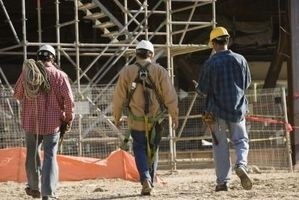How To Reduce Workplace Injuries In The Construction Industry

More than 11 million construction workers in the U.S. build, repair and demolish roads, bridges and buildings under highly hazardous conditions, according to a 2009 report by the National Institute for Occupational Safety and Health (NIOSH). While construction workers comprise 8 percent of the workforce, they are involved in 22 percent of workplace fatalities. The construction workplace is wherever the worker performs the job, including outdoors, indoors, high places, confined spaces and environments where workers are exposed to dangerous machinery, heavy equipment, chemicals, noise, traffic and other hazards.
Instructions
1.Evaluate and implement safety plans using professional consultants and resources. The Occupational Safety and Health Administration (OSHA), an office of the U.S. Department of Labor, provides resources, safety signs and literature and training designed for workers and employers in the construction industry. For instance, OSHA provides guidelines and training for the use of scaffolding by construction workers and regulations for handling hazardous materials.
2.Provide safety and skills training, including the use of equipment, proper lifting, working at heights, responding to hazards and other skills used in the construction industry. OSHA provides industry-specific training, guidelines and assistance complying with workplace safety laws and regulations. Trained employees are prepared for different work environments and equipment, and they understand the importance of injury prevention.
3.Institute plans for consistent inspections of the machines, equipment and tools used by workers. Plans should include preventive maintenance, repair and replacement and instructions to workers for how to handle problems.
4.Implement safety regulations and require all employees to follow the regulations at all times, including reporting hazards, wearing safety clothing and equipment and proper use of equipment.
5.Post safety regulations and warnings for a multilingual workplace where workers see them frequently. These safety notices should include Material Safety Data Sheets for all chemicals, according to the NIOSH.
6.Provide clean, secure toilet facilities and allow workers to use them at will. Workers who wait long periods to use toilet facilities are more prone to workplace injuries, according to the NIOSH.
7.Collect and evaluate information on workplace injuries to make necessary changes, such as additional training and improved equipment.
8.Maintain a culture of safety by providing printed safety manuals, consistently using safety language and terms, building safety skills and requirements into all job descriptions, adopting zero tolerance for violations, requiring supervisors to place safety above productivity and assigning a committee to oversee the workplace's safety plan.
Instructions
1.Evaluate and implement safety plans using professional consultants and resources. The Occupational Safety and Health Administration (OSHA), an office of the U.S. Department of Labor, provides resources, safety signs and literature and training designed for workers and employers in the construction industry. For instance, OSHA provides guidelines and training for the use of scaffolding by construction workers and regulations for handling hazardous materials.
2.Provide safety and skills training, including the use of equipment, proper lifting, working at heights, responding to hazards and other skills used in the construction industry. OSHA provides industry-specific training, guidelines and assistance complying with workplace safety laws and regulations. Trained employees are prepared for different work environments and equipment, and they understand the importance of injury prevention.
3.Institute plans for consistent inspections of the machines, equipment and tools used by workers. Plans should include preventive maintenance, repair and replacement and instructions to workers for how to handle problems.
4.Implement safety regulations and require all employees to follow the regulations at all times, including reporting hazards, wearing safety clothing and equipment and proper use of equipment.
5.Post safety regulations and warnings for a multilingual workplace where workers see them frequently. These safety notices should include Material Safety Data Sheets for all chemicals, according to the NIOSH.
6.Provide clean, secure toilet facilities and allow workers to use them at will. Workers who wait long periods to use toilet facilities are more prone to workplace injuries, according to the NIOSH.
7.Collect and evaluate information on workplace injuries to make necessary changes, such as additional training and improved equipment.
8.Maintain a culture of safety by providing printed safety manuals, consistently using safety language and terms, building safety skills and requirements into all job descriptions, adopting zero tolerance for violations, requiring supervisors to place safety above productivity and assigning a committee to oversee the workplace's safety plan.
- 2j684b4bf7321f18c439cf91ebb5a030e6.jpg
References
http://www.ehow.com/how_7557364_reduce-workplace-injuries-construction-industry.html
http://img.ehowcdn.com/615x200/ehow/images/a07/6k/7k/reduce-workplace-injuries-construction-industry-800x800.jpg